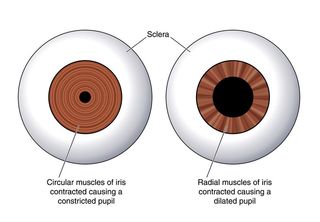SURAH AL GHAAFIR (THE FORGIVER): AYAT 19 (QURAN 40:19)

Is it truth or is it a lie? Sometimes a very difficult question indeed. One physiologic “tell” of a lie is the possibility of Pupil Dilation. Normally, as part of the pupillary light reflex, the pupil dilates in the dark and constricts in the light to respectively improve vividity at night and to protect the retina from sunlight damage during the day. The excitation of the radial fibers of the iris which increases the pupillary aperture is referred to as a mydriasis. More generally, mydriasis also refers to the natural dilation of pupils, for instance in low light conditions or under sympathetic stimulation.

The mechanism of mydriasis depends on the agent being used. It usually involves either a disruption of the Autonomic Nervous System: either the parasympathetic nerve supply to the eye (which normally constricts the pupil) or overactivity of the sympathetic nervous system (SNS). Multiple studies have noted that the pupil typically dilates >4%-8% of the initial pupil diameter and an increase in the number of blinking of the eye up to 8 times from the initial blink of the respondent when telling a lie. On this research the accuracy of lie detector system is 84%.
EyeDetect is a commercially available system utilizing (mostly) pupil response and eye movements to help determine lying behaviors. Some of their data notes:
April 2020: Dr. Andrew Potts published the results of a lab study conducted at the University of Utah with a new multi-issue comparison test (MCT) protocol. In that study, EyeDetect achieved two amazing milestones: (1) 88% accuracy and (2) the capability of scoring up to 4 relevant issues in a single test.
In the European Polygraph Journal (Dec. 2016), Dr. John Kircher and Dr. David Raskin reported that when used for screening tests, EyeDetect is 88% accurate (based on field studies).
As an anecdotal example, Converus tested 66 polygraph examiners attending the American Polygraph Association (APA) seminar in Baltimore in 2016 with an EyeDetect number test. Of the 66 tests administered, EyeDetect determined the correct number 63 times. That is an accuracy rate of 95.5%. Tests were administered in English, Spanish and Arabic. Note: The probability of randomly guessing the correct number would be 1 of 8 or 12.5%.
In June 2021, Dr. John Kircher published the results of two lab studies on a Hybrid Multi-Issue Comparison Test (MCT) protocol and a Hybrid Directed Lie Comparison (DLC) Test. The term “hybrid” refers to a combination of ocular-motor and polygraph physiology measures and question formats. In those studies, EyeDetect achieved two milestones: (1) 88% accuracy for the Hybrid DLC and (2) 91% accuracy for the Hybrid MCT. The DLC format is used for specific issue tests (investigations primarily) and the MCT format is used for screening tests.
All tests have error rates. For every 100 guilty or 100 innocent people tested, EyeDetect accurately classifies 88 people in screening tests and 90 in diagnostic tests. That means it inaccurately classifies 12 out of 100 people in screening tests and 10 out of 100 in diagnostic testing. A very impressive result that typically outperforms classic Polygraph testing (classic lie detector test – Despite claims that polygraph tests are between 80% to 90% accurate by advocates, the National Research Council has found no evidence of effectiveness) .
To summarize – Pupils typically dilate when humans lie – as Allah (SWT) states in the Quran: the Fraud of the Eyes!
